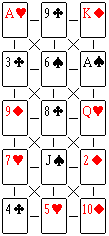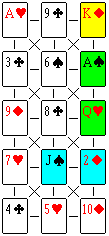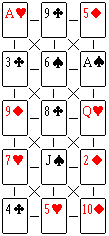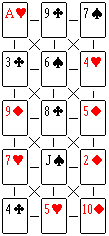Thirteens Simple Solitaire Rules
Thirteens Simple (or just "13's") is a solitaire card game created by Randy Rasa for use in his Simple Pleasures collection. It is part of the "simple addition" family of solitaires, which includes games such as Pyramid, Fifteens, and Elevens.
Setup
 The game is begun by dealing five rows of three cards each
(face-up) to form the tableau. The remaining cards form the stock. Numerical cards
are worth their value, Aces count as 1, Jacks as 11, Queens as 12, and Kings as 13.
The game is begun by dealing five rows of three cards each
(face-up) to form the tableau. The remaining cards form the stock. Numerical cards
are worth their value, Aces count as 1, Jacks as 11, Queens as 12, and Kings as 13.
The object of the game is to remove pairs of cards that add up to 13, and are adjacent to each other, either vertically, horizontally, or diagonally. (Referring to the diagram at the left, the black lines between cards show valid sources of pairs.) Kings, since their value is 13, are removed singly.
As cards are removed from the tableau, the cards "above" fall into the holes, and new cards are added from the stock. This creates a constantly-shifting layout, making possible new pairs where none existed before (and occasionally, if you're not careful, breaking up pairs that previously existed).
Example
 Using the cards above as an example, the following cards are candidates to be
removed (refer to highlighted cards in the diagram on the left):
Using the cards above as an example, the following cards are candidates to be
removed (refer to highlighted cards in the diagram on the left):
- The king of diamonds (value = 13).
- The ace of spades (value = 1) and the queen of hearts (value = 12).
- The jack of spades (value = 11) and the 2 of diamonds (value = 2).
As the first step, we'll remove the king of diamonds. The space created will be filled from the top card of the stock.
 You can see that the king of diamonds has been removed, and replaced with
a five of diamonds from the stock. We now have two possible moves that can be made:
You can see that the king of diamonds has been removed, and replaced with
a five of diamonds from the stock. We now have two possible moves that can be made:
- The ace of spades (value = 1) and the queen of hearts (value = 12).
- The jack of spades (value = 11) and the 2 of diamonds (value = 2).
As the next step, we'll take away the ace of spades and the queen of hearts. This will create two spaces in the tableau, and will cause two actions to occur:
- The 5 of diamonds will fall down into the position previously held by the queen of hearts.
- Two cards will be drawn from the stock to fill the empty spaces.
 Assuming that a 4 of hearts and a 7 of spades are drawn from the stock,
you can see that this creates several more possible pairs:
Assuming that a 4 of hearts and a 7 of spades are drawn from the stock,
you can see that this creates several more possible pairs:
- The 9 of clubs and the and the 4 of hearts
- The 6 of spades and the 7 of spades
- The 8 of clubs and the 5 of diamonds
- The jack of spades and the 2 of diamonds
I trust that, by this point, you've got it figured out. Continue removing cards until you either remove them all, or reach an impasse. If a column becomes empty, you may take the top card of either of the other two columns and move it into the bottom position of the empty column.
Strategy
In general, I find it most advantageous to remove cards from the center column whenever possible, since cards in that column may be matched up with cards in either the left or right columns, creating twice as many possibilities for new pairs.
I tend to remove kings at once, and remove cards from the top of the layout before cards from the bottom. I'm not sure if either of these actions has any real impact on the outcome, though ...
Other than that, there's not a huge amount of strategy involved here. Just stay alert for new pairs created as cards fall down the columns, and watch out for pairs that may be disturbed by carelessly-removed cards.
Other Layouts
If you're playing this game "by hand", you may want to experiment with other card configurations. I chose three columns of five cards each because it fit nicely on the screen, but other layouts are certainly possible, and may in fact offer some advantages.
For example, if you increased the number of columns to five, you'd then have three "middle" columns, greatly increasing the number of possible plays.
On the other hand, by using more columns, you'd also increase the chances of having the cards you need being on distant parts of the tableau. This is one case where I suspect it is better to have the layout "tall and thin" rather than "short and fat".
Odds
Your chances of winning are about one out of every three or four games. Here are my current statistics:
- Games Played: 238
- Games Won: 70 (29.41%)
- Average Score: 32.34
The rules to this game are copyright Randy Rasa, and neither the rules nor the game they describe may be reproduced without written permission.
